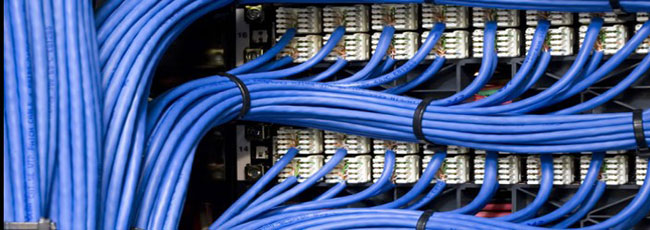A structured cabling is system comprises system of cabling and associated hardware. Structured cabling is the basic telecommunication infrastructure. A telecommunication infrastructure serves as medium to offer telephone and data transmission services. It is independent of device. The structured cabling originates at the point where service provider terminates. This point is called point of demarcation or Network Interface Device (NID).

For instance, during installation of telephone system, if customer requires one or more service lines, Service Provider (SP) connects lines at NID. Structured cabling may vary according to location and needs of the consumer. Architectural structure of the buildings is different and every location of houses is different. Connection systems also used to vary. Sometimes, customer requires having flexible cabling installation to support present and future devices.
Standardization
Structured cabling is governed by standards that specify the design of the system, which connects buildings to communication system through cable. Standardization is important in order to ensure all systems are supported and performance is improved with the complex arrangements.
Most common categories are:
- Category 5e
- Category 6
- Fiber optic cabling
- Modular connectors
These standards decide the topology of the cabling.
In US, American National Standard Institute (ANSI) is followed for structured cabling installation. In addition, TIA/EIA oversees the standards and practices in installing and maintaining cabling systems.
US standards for cabling industry as follows:
- ANSI/TIA-568-C.0, Generic Telecommunication Cabling for single customer, 2009
- ANSI/TIA-568-C.1, Telecommunication Cabling for Commercial Building, 2009
- ANSI/TIA-568-C.2, Telecommunication cabling and component standard(Balanced and twisted pair), 2009
- ANSI/TIA-568-C.3, Cabling components standard in Optical Fiber, 2008
- TIA-569-B, Commercial standard for Telecommunication pathways and spaces in Building
- ANSI/TIA/EIA-606-A-2002, Administration Standard for Commercial infrastructure.
Types of network
The industry has divided it network based on type of area. LAN (local area network) is used small areas such as a society or building. MAN (metropolitan area network) is used for the metropolitan area. And WAN (Wide area network) is used for area which is spread.
Installation
Structure cabling installation includes entrance facility, backbone pathways, backbone cables, work area outlets, equipment rooms, closets, connection facilities, MUTOA (multi-user telecommunications outlet assemblies), transition and consolidation points.
An entrance facility provides a medium to connect services to local cabling. This system may include, pathways, cables, hardware, circuit protectors and transition hardware. It also demarcates between SP and customer premises. Protection device are installed according to the national electrical codes. Location of it is determined by type of premises, route, structure of the building, and aesthetics. There are four types of entrance facilities:
- Buried
- Underground
- Aerial
- Tunnel
Backbone Cabling
From the entrance facility, structure cabling is divided and goes forward to other buildings, floors, with in the same customer premise. Backbone cables handle the major traffic for the premises. According to standards, backbone cabling provides interconnections to various elements of the system like, closets, equipment rooms, and entrance facility. It includes backbone cables, cross connects, mechanical terminations, and cords or jumpers. Inter and intra building cabling is two type of backbone cabling. Inter building handles the traffic between network of two buildings and intra building handles the traffic between closets with in the building. Backbone cabling divided into two levels one is between main and intermediate cross connects, and second is between horizontal and intermediate cross connects.
Connectors
Connectors are mechanical devices that are used to provide interface between two equipment pieces through cables. It offers coupling to reduce the losses. In case of fiber optics, light impulse is allowed to pass through it. For good connection alignment is important for the connectors. This ensures that light or signals travel through it efficiently. Connectors are essential to integrate whole telecommunication as one cable.
About The Author
Michelle Patterson is an avid technology blogger and writes extensively about IP/VoIP and Unified Communication. She works with some leading companies to understand the trends of these modern communication technologies.
Structured Network Cabling Infrastructure,





Chris
May 30. 2018
Really helpful post, I was writing a similar article and found this while researching so thank you very much!
Adam Joseph
Oct 04. 2018
Expect to see more trends that depend on the IoT in the coming years. Thanks for sharing.